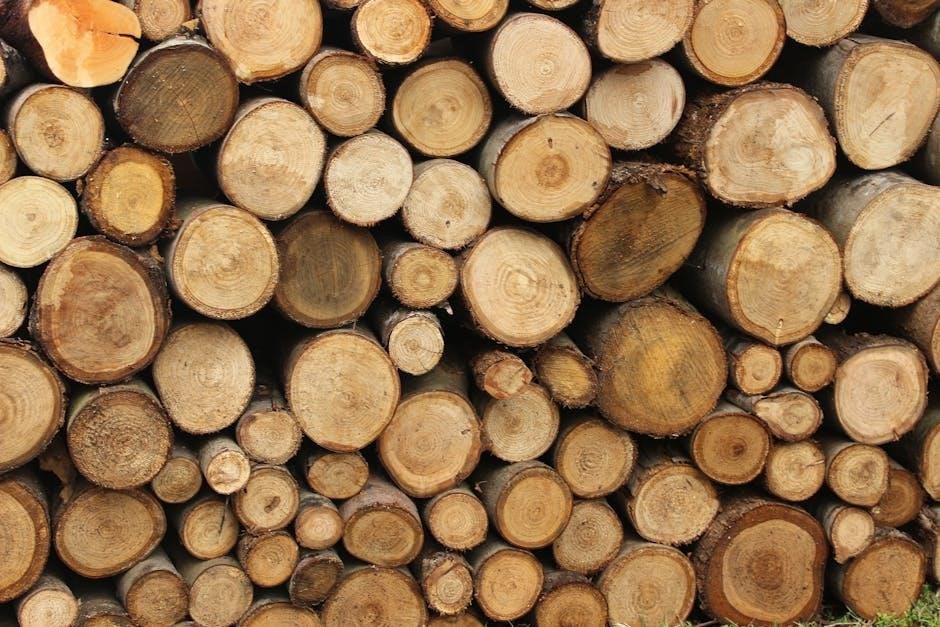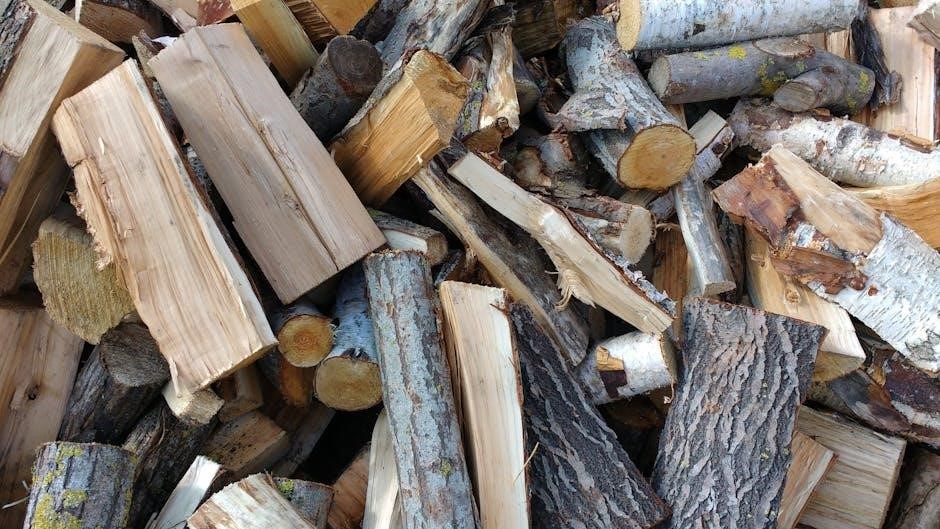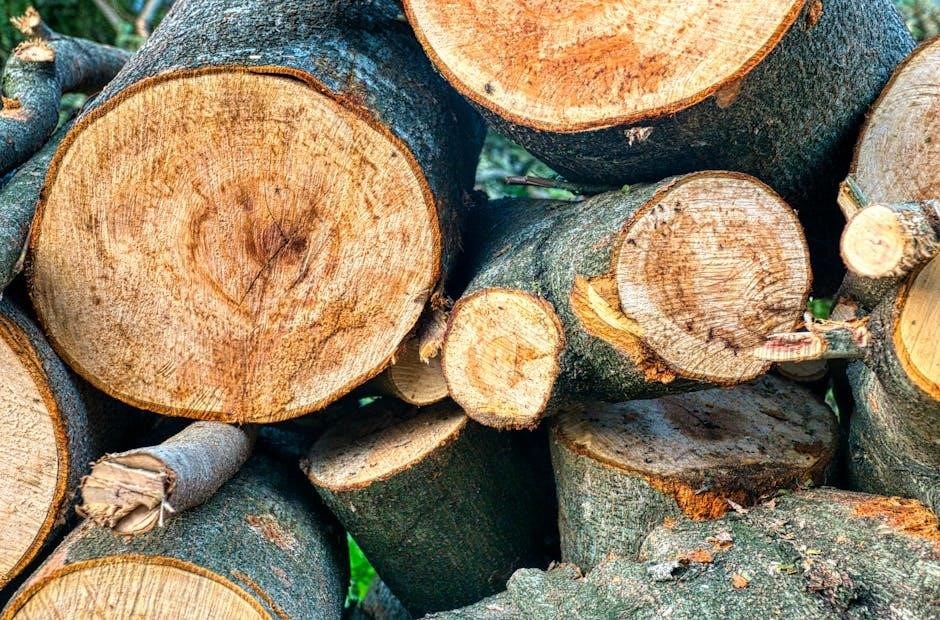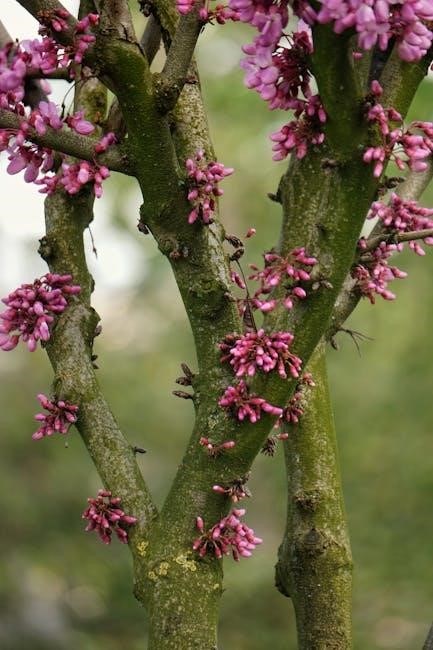Tree bark serves as a key identifier for firewood, offering visual clues like color, texture, and patterns. Hardwoods and softwoods exhibit distinct characteristics, aiding in accurate species recognition. Examining bark, along with end grain patterns and wood scent, provides a comprehensive approach to firewood identification, ensuring efficient and safe burning practices.
Importance of Tree Bark in Firewood Identification
Tree bark plays a vital role in firewood identification, as its unique characteristics provide essential clues about the wood’s species, quality, and burn efficiency. Bark color, texture, and patterns vary significantly between hardwoods and softwoods, aiding in accurate recognition. For instance, oak bark is thick with deep furrows, while pine bark is scaly and reddish-brown. These distinctions help determine the wood’s heat output, burn duration, and smoke production. Identifying firewood by bark ensures proper seasoning and safety, as certain species, like cherry, offer a clean burn, while others, like cedar, may produce excessive smoke. Additionally, bark helps identify moisture content, with seasoned wood often displaying weathered or grayish hues. Accurate identification prevents the use of unsuitable or hazardous wood, ensuring efficient and safe combustion. By examining bark, users can make informed decisions about firewood selection for optimal performance and environmental safety.
Overview of Hardwood and Softwood Characteristics
Hardwoods and softwoods exhibit distinct characteristics that aid in identification. Hardwoods, derived from deciduous trees like oak and maple, typically have broad leaves and dense wood. Their bark often features deep furrows, irregular ridges, or smooth, elephant-skin textures, as seen in beech. Softwoods, from coniferous trees such as pine and fir, usually have needle-like leaves and less dense wood. Their bark tends to be scaly, resinous, or fibrous, with species like cedar displaying stringy, peeling layers. Understanding these differences helps in recognizing firewood types, as hardwoods generally burn longer and hotter, while softwoods ignite faster but produce more resin. Accurate identification ensures proper use, optimizing burn efficiency and safety. These characteristics are crucial for selecting the right firewood for specific needs, whether for heat, cooking, or environmental considerations.

Hardwood Tree Bark Identification
Hardwood tree bark varies widely, offering unique identification features. Oak bark has deep furrows, while hickory displays flaky, ridged patterns. Beech bark is smooth, and maple bark is tight and skin-like, aiding in species recognition through distinct textures and visual cues.
Oak Tree Bark: Deep Furrows and Irregular Ridges
Oak tree bark is one of the most iconic and easily recognizable due to its deep furrows and irregular ridges. As the tree matures, the bark becomes increasingly rugged, developing a mosaic of vertical plates and grooves. These furrows can vary in depth and width, creating a unique, textured appearance. The bark often has a grayish color, though it can darken with age. A key feature of oak bark is its thickness, which provides protection against environmental stressors. The irregular ridges and furrows are crucial for identification, as they distinguish oak from other hardwoods like maple or beech. Additionally, the bark’s texture and pattern remain consistent across many oak species, making it a reliable trait for firewood identification. Examining these characteristics closely ensures accurate recognition of oak firewood, essential for understanding its burning properties and quality.
Hickory Tree Bark: Flaky, Gray, and Ridged Patterns
Hickory tree bark is easily identifiable by its flaky, gray appearance and distinctive ridged patterns. As the tree matures, the bark develops deep furrows and sheds in thin, vertical strips, creating a shaggy texture. The bark’s color ranges from light to dark gray, often with a reddish tint in younger trees. A notable feature of hickory bark is its ability to peel easily, especially in mature specimens, revealing a smoother, lighter-gray underside. The combination of flaky layers and ridged patterns makes hickory bark unique among hardwoods. This texture is particularly useful for identifying hickory firewood, as it contrasts with smoother barks like maple or beech. The bark’s appearance can vary slightly with age and environmental factors, but its flaky, ridged pattern remains a consistent identifier. Recognizing these traits helps in distinguishing hickory from other species, ensuring accurate firewood identification and understanding its high heat output when burned.
Beech Tree Bark: Smooth, Light Gray, and Elephant-Skin Texture
Beech tree bark is renowned for its smooth, light gray surface, which develops a unique elephant-skin texture as the tree matures. This distinctive texture, characterized by small, rounded bumps and slight furrows, sets beech apart from other hardwoods. The bark remains smooth throughout the tree’s life, with only minor cracking in older specimens. Its light gray coloration is consistent, though it may darken slightly with age. The elephant-skin texture becomes more pronounced over time, creating a rugged yet smooth appearance. This bark pattern is highly recognizable and aids in identifying beech firewood, which is prized for its high heat output and durability. When examining beech firewood, look for a smooth, gray exterior with the characteristic texture, as this is a reliable indicator of the species. This unique bark feature makes beech one of the easier hardwoods to identify, even in seasoned firewood form.
Cherry Tree Bark: Shiny, Brown or Gray with Tiger-Stripe Grooves
Cherry tree bark is easily identifiable due to its shiny, smooth surface, which ranges in color from brown to gray. As the tree matures, deep reddish-brown grooves develop, resembling tiger stripes, adding a distinctive visual pattern. These grooves are narrow and sharply defined, creating a striking contrast against the bark’s overall luster; The bark’s texture remains smooth, even as the tree ages, though it may develop slight scaling in older specimens. The tiger-stripe grooves are a key feature for identifying cherry firewood, as they are unique among hardwood species. When examining seasoned firewood, look for these characteristic grooves and the bark’s shiny appearance, which persists even after seasoning. This visual signature makes cherry firewood one of the most recognizable, combining aesthetic appeal with its high-quality burning properties. The bark’s color and pattern are essential for accurate identification, ensuring the correct species is selected for its desired use.
Maple Tree Bark: Tight and Skin-Like Texture
Maple tree bark is renowned for its tight, skin-like texture, which remains smooth and unblemished even as the tree matures. The bark typically presents a light gray color, sometimes with subtle hints of brown, and lacks the deep furrows or flaky patterns seen in other hardwood species. Its tight adherence to the wood gives it a clean, almost polished appearance. Unlike oak or hickory, maple bark does not develop pronounced ridges or peeling layers, making it easily distinguishable. The smooth, unbroken surface is a key identifier, especially when leaves or other features are unavailable for examination. This characteristic texture is consistent across most maple species, though slight variations in color may occur. The bark’s tightness also means it resists weathering, retaining its appearance even in seasoned firewood. This unique feature makes maple bark a reliable visual cue for identification purposes.
Sycamore Tree Bark: Flaky Exterior with Whitish-Green Undertones
Sycamore tree bark is easily recognizable due to its striking flaky exterior, which peels away in large, irregular patches. Beneath the flakes, the bark reveals a whitish-green underlayer, creating a stark contrast that makes sycamore wood highly distinctive. This flaky pattern is particularly noticeable on mature trees, where the bark tends to shed in thin, papery strips. The combination of the peeling, multi-layered exterior and the vibrant underlying color provides clear visual cues for identification. Seasoned sycamore firewood retains these characteristics, with the whitish-green tones often visible at the wood’s edges. The bark’s appearance is further accentuated by its tendency to become more prominent at the ends of branches and the upper sections of the tree. This unique feature makes sycamore one of the easiest species to identify, even when other distinguishing elements like leaves are absent. The flaky, multi-colored bark is a reliable marker for recognizing sycamore firewood.
Softwood Tree Bark Identification
Softwood tree bark varies by species, with pine featuring scaly textures, fir displaying smooth surfaces with resin blisters, and spruce showing rough, reddish-brown layers. Cedar bark is fibrous and often peels in strips.

Pine Tree Bark: Reddish-Brown to Gray-Brown with Scaly Texture
Pine tree bark is easily recognizable due to its distinctive reddish-brown to gray-brown color and scaly texture. As the tree matures, the bark develops deep furrows and separates into thick, plate-like scales. Younger pines often have smoother bark that darkens with age. One of the key identifying features of pine bark is its sticky sap, which can leave resinous blisters on the surface. The texture is typically rough to the touch, with visible ridges and grooves. Pine trees are also accompanied by their needle-like leaves, which can aid in identification when bark alone is not sufficient. The bark’s scaly pattern and coloration make it a reliable indicator for distinguishing pine firewood from other softwoods. Seasoned pine firewood often has a weathered appearance, with the bark becoming more brittle and fragmented over time.
Fir Tree Bark: Thinner, Smoother with Resin Blisters
Fir tree bark is characterized by its thin, smooth texture, typically ranging in color from grayish-brown to silvery-gray. Unlike pine, fir bark remains relatively smooth even as the tree ages, with minimal furrowing or scaling. A distinctive feature of fir bark is the presence of resin blisters or pockets, which appear as small, rounded or oval-shaped protrusions on the surface. These blisters can secrete a fragrant resin, adding to the tree’s aromatic properties. The bark’s smoothness and lack of deep ridges make it easily distinguishable from other softwoods like pine or spruce. As fir trees mature, the bark may develop slight peeling or flaking, but it generally retains its smooth appearance. Seasoned fir firewood often has a lighter color and a more brittle texture, with the resin blisters becoming less pronounced over time. These characteristics make fir bark a reliable indicator for identifying firewood species.
Spruce Tree Bark: Scaly and Rough with Reddish-Brown Color
Spruce tree bark is scaly and rough, typically displaying a reddish-brown to grayish-brown color. As the tree matures, the bark becomes thicker and more deeply furrowed, with prominent scales that peel away in thin layers. The texture is often described as coarse and uneven, contrasting with the smoother bark of younger trees. Resin blisters may occasionally appear, though they are less frequent compared to fir. Seasoned spruce firewood retains these scaly patterns, with the bark often showing signs of weathering. The combination of color, texture, and scaling makes spruce bark distinctive among softwoods. When identifying spruce firewood, look for these characteristics, as they differ notably from the smoother, resin-rich bark of fir or the scaly, plated texture of pine. This unique appearance aids in accurate species recognition, ensuring proper identification for firewood use.
Cedar Tree Bark: Fibrous or Stringy, Often Peeling in Strips
Cedar tree bark is known for its fibrous or stringy texture, often peeling in long, thin strips. The bark typically ranges in color from reddish-brown to gray, depending on the species. Its unique texture and peeling pattern make it easily distinguishable from other softwoods. As the tree ages, the bark becomes more pronounced, with deep grooves forming between the fibrous layers. Cedar bark often has a distinctive aromatic scent, adding to its identifiable characteristics. When identifying cedar firewood, look for the telltale peeling strips and the reddish undertones beneath the outer layers. This distinctive bark pattern, combined with its color and texture, makes cedar one of the easier softwoods to recognize. The bark’s appearance can vary slightly with environmental factors, but its fibrous, stringy nature remains a consistent identifying feature.
Additional Firewood Identification Methods
Beyond bark, firewood identification involves examining end grain patterns, leaf characteristics, and wood scent. These methods provide complementary clues for accurate species recognition, enhancing identification reliability and efficiency.
Examining End Grain Patterns for Species Recognition
Examining end grain patterns is a valuable method for identifying firewood species. The arrangement of growth rings, their size, and distinctive features like rays can reveal the wood’s origin. Oak, for instance, has prominent rays visible in its end grain, while elm displays wavy patterns. A hand lens can aid in detailed analysis. This method is particularly useful when bark is missing or unidentifiable; The color of the end grain, such as cherry’s consistent red hue, also provides clues. While end grain analysis is effective, some species may have similar patterns, requiring additional methods for confirmation. Combining this technique with bark and leaf identification enhances accuracy, ensuring proper recognition of firewood species for optimal use.
Leaf Characteristics for Firewood Identification
Leaf characteristics provide a straightforward method for identifying firewood species, especially when leaves are present. Maple leaves, with their distinctive five-lobed shape, are easily recognizable, aiding in identifying various maple types. Oak leaves also have a unique five-lobed structure, though shapes can vary. Hickory trees feature compound leaves with 7-9 leaflets, distinguishing them from walnuts, which typically have more. Ash trees are identified by their opposite compound leaves, a feature that sets them apart from other species; Leaf arrangement, whether alternate or opposite, and leaflet count are crucial for accurate identification; However, this method is less effective for firewood without leaves. Consulting reliable sources for precise leaf identification is essential, especially for specific geographic regions. By considering these factors, leaf characteristics become a valuable tool in firewood identification, complementing bark and end grain analysis for a comprehensive approach.
The Role of Wood Scent in Identification
The scent of wood plays a significant role in firewood identification, as different tree species emit unique aromas. Hickory, for instance, is known for its strong, smoky smell, often associated with barbecue. Cedarwood has a distinctive, pleasant aroma, while birch emits a sweet, wintergreen-like scent. Cherry and maple woods often have mild, slightly sweet smells. These scents are more pronounced when the wood is freshly cut or split, making them useful for identification. Seasoned wood may lose some of its aroma, but traces remain. The scent can also indicate the wood’s origin and condition, such as dampness or decay. While scent alone isn’t always definitive, it complements other methods like bark and grain analysis. Recognizing these distinctive smells enhances firewood identification accuracy and helps in selecting the best wood for specific uses, such as cooking or heating.

Practical Considerations for Firewood Use
Properly seasoned hardwood ensures efficient burning, while softwoods may produce more smoke. Store firewood away from structures to prevent pests and accidental ignition. Avoid treated or damp wood for safety and environmental concerns.
Seasonal Factors in Firewood Identification and Usability
Seasonal variations significantly impact firewood identification and usability. During the growing season, leaves are more abundant, aiding in species recognition. However, in colder months, weathering and insect damage can obscure bark characteristics, making identification challenging. Moisture content is crucial, as seasoned wood burns more efficiently and cleanly. A moisture meter is recommended to ensure wood is dry, typically with a moisture content below 20%. Seasoned wood often appears grayish or weathered and produces a hollow sound when tapped. Properly seasoned firewood is essential for optimal burning, reducing smoke and creosote buildup. It’s important to avoid using unseasoned wood, as it burns inefficiently and can release harmful emissions. Always consider the time of year and wood condition for accurate identification and safe use.
Moisture Content and Its Impact on Burning Quality
Moisture content is a critical factor in determining the quality and efficiency of firewood. High moisture levels in wood lead to poor combustion, producing excessive smoke and creosote buildup in chimneys. This not only reduces the heat output but also poses a fire hazard. Well-seasoned wood, with a moisture content of less than 20%, burns cleaner and hotter, ensuring a safer and more efficient fire. To assess moisture levels, one can use a moisture meter or observe physical signs such as cracks in the wood or a hollow sound when tapped. Proper seasoning is essential, as it allows the wood to dry out thoroughly, enhancing its burning qualities. Always prioritize seasoning to optimize the performance and safety of your firewood.
Safety Tips for Handling and Burning Firewood
Safety is paramount when handling and burning firewood. Always wear gloves to protect hands from splinters and sharp edges. Store firewood away from structures to minimize fire hazards and prevent pest infestations. Ensure proper ventilation in the burning area to avoid carbon monoxide buildup. Avoid burning treated or painted wood, as it releases harmful chemicals. Never burn driftwood, as it may contain contaminants like salt. Use a fireplace screen to contain sparks and embers. Keep a fire extinguisher or water source nearby. Only burn well-seasoned wood with low moisture content to reduce smoke and creosote accumulation. Regularly inspect and clean chimneys to prevent dangerous blockages. Follow local burning regulations and consult fire safety guidelines for additional precautions. Prioritizing these practices ensures a safer and more enjoyable firewood-burning experience.
Tree bark is a vital tool for firewood identification, offering insights into species through color, texture, and patterns. This guide simplifies recognizing hardwoods and softwoods, ensuring safe and efficient burning practices.
Identifying firewood by tree bark involves examining color, texture, and patterns. Hardwoods like oak, hickory, and beech exhibit unique traits, such as deep furrows, flaky surfaces, or smooth, elephant-skin textures. Softwoods, including pine, fir, and cedar, display scaly, resinous, or fibrous characteristics. Key features include color variations, from light gray to reddish-brown, and distinctive patterns, like tiger stripes on cherry or peeling layers on birch. Bark thickness and density also vary, with oaks having thick, ridged bark and sycamores revealing whitish-green undertones. While bark is a primary identifier, additional methods like end grain analysis and wood scent can aid accuracy. Recognizing these features ensures proper species identification, essential for optimal burning performance and safety. This guide highlights the most critical traits for effective firewood identification, enabling users to make informed decisions.
Best Practices for Effective Firewood Identification
For accurate firewood identification, prioritize a thorough examination of bark, end grain, and wood scent. Combine these methods for reliable results, as no single trait guarantees identification. Consult detailed guides or experts when unsure. Seasonal adjustments are crucial; inspect bark for weathering and leaves for species-specific shapes. Store firewood properly to maintain its condition and accessibility. Always prioritize safety by avoiding treated or rotten wood, which can release harmful chemicals. Opt for well-seasoned hardwoods for cleaner burns and minimal smoke. Familiarize yourself with local tree species to enhance identification accuracy. Use tools like hand lenses for detailed grain analysis and moisture meters to ensure wood is ready for burning. By following these practices, you can identify firewood effectively, ensuring efficient and safe use in heating and cooking applications.

